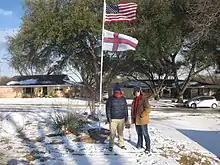Faroese Americans
Faroese Americans (Faroese: føroyskir amerikumenn) are Americans of Faroese descent or Faroe Islands-born people who reside in the United States. The Faroe Islands are a group of eighteen islands between Iceland and Norway, and they are a part of the Kingdom of Denmark. Because many immigrants were identified by their Danish citizenship, it is not known how many Faroese Americans there are.[1]
| Regions with significant populations | |
|---|---|
| California | |
| Languages | |
| English, Faroese | |
| Related ethnic groups | |
| Danes, Danish Americans, Greenlanders, Greenlandic Americans, Danish Canadians, Danish Australians, Scandinavian Americans, Norwegian Americans, European Americans |
History
The Faroe Islands were originally settled by Norsemen around 800 AD, and remained in contact with Iceland and Scandinavia throughout the Viking Era. This settlement was a part of the same population movement that brought the Norse to North America around 1000 AD.[2]
Unlike many European countries, the Faroe Islands did not industrialize and did not experience the same population pressures which drove many Scandinavians to immigrate to the United States during the 17th and 18th centuries. In fact, the opposite was occurring in the Faroe Islands. Due to shipping restrictions and monopolistic control of goods traveling to the islands, there was a famine, exacerbated by the lack of grain going to the Faroe Islands from Denmark. Additionally, Danish laws were created that effectively barred the poor from marriage to keep the population low.[2]
Immigration and settlement
Faroese American immigration differs significantly from that of most groups of Europeans. Faroese Americans did not come to the United States in large groups, but instead came as individuals. Men often immigrated to the United States to work, especially as sailors. Women often immigrated to the United States through marriage to Americans. Because of the individual style of immigration and the smaller numbers, there is not as cohesive a Faroese American community, as there is for many other immigrant groups to the United States.[1] Some Faroe Islanders also converted to Mormonism and Seventh-day Adventism, and so then moved to Denmark to be a part of the larger Mormon and Seventh Day Adventist communities there. From Denmark, some further immigrated to the United States, often in larger groups, as was common for Danish emigration. However, very few people overall left the Faroe Islands.[3]
There is evidence that Faroese Americans settled widely across the United States, and did not refine themselves to simply the areas settled by many Scandinavian Americans. In context, this makes a lot of sense, as Faroese Americans immigrated mostly as individuals, and often had different skill sets than Scandinavian Americans, namely, seafaring abilities.[1] Additionally, around the 1850s, the Faroe Islands started to develop their own national identity, and so many Faroese Americans may not have identified closely with Scandinavian Americans that they would feel the need to live amongst them.[4] However, there is anecdotal evidence that many Faroese Americans settled in Colorado and the West Coast.
Faroese Ethnic Identity

Faroese ethnic identity is rooted in a strong sense of place, hospitality, and family connections. Faroese people have a strong tradition of hospitality, which includes inviting distant family members they have never met to stay at their house or for a complete meal.[1] In the Faroe Islands, many people keep in touch with distant relatives, even so far as third cousins, and so family connections are extremely important.[5]
Difficulty in Determining Numbers
Because the Faroe Islands are a part of the Kingdom of Denmark, Faroese people have Danish citizenship. This means that in old census records, Faroese Americans would identify themselves as having Danish citizenship.[1] Compounding this issue, Denmark created some laws that forced Faroese people to adopt a consistent last name during the 1800s, and the new last names were often Danish.[6] Especially common are Jensen and Joensen, which are indistinguishable from Danish last names. Therefore, it is an extremely difficult task to estimate the number of Faroese Americans based on census records. Additionally, handwritten records may be mis-transcribed as the Fiji Islands, the Virgin Islands, the Azores Islands, Rhode Island, Fayal Island, the Island of Fohr, or others. Additionally, spelling mistakes for villages from the Faroe Islands makes it difficult to determine immigration. This makes handwritten records unreliable or incomplete concerning the Faroe Islands. Instead, passenger lists should be explored. Research in Faroese, Danish, and American archives is ongoing.[1]
References
- Douma, Michael J. (3 June 2016). "Faroese-Americans: Some Preliminary Research on an Immigrant Group without a Written History". Michael J Douma. Retrieved 2022-12-12.
- Wylie, Jonathan (1987). The Faroe Islands: Interpretations of History. University Press of Kentucky. ISBN 9780813115788. JSTOR j.ctt130jng0.
- Coull, James R. (1967). "A Comparison of Demographic Trends in the Faroe and Shetland Islands". Transactions of the Institute of British Geographers (41): 159–166. doi:10.2307/621333. JSTOR 621333.
- Nauerby, Tom (1996). No Nation is an Island: Language, Culture, andNational Identity in the Faroe Islands. North Atlantic Monographs. Aarhus: Aarhus University Press. p. 237. ISBN 8798342452.
- "Færøsk kultur". Visit Faroe Islands (in Danish). Archived from the original on 2017-09-24. Retrieved 2017-11-08.
- Barfoed, Lars (23 February 2005). "2004/2 LSF 27: Forslag til Navnelov". Retsinformation (in Danish).